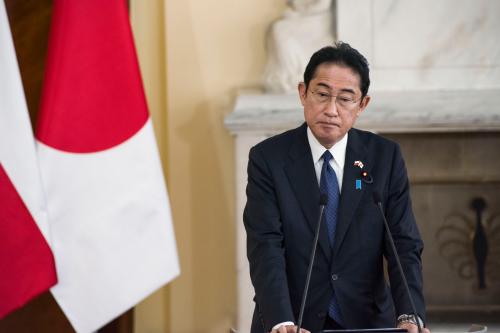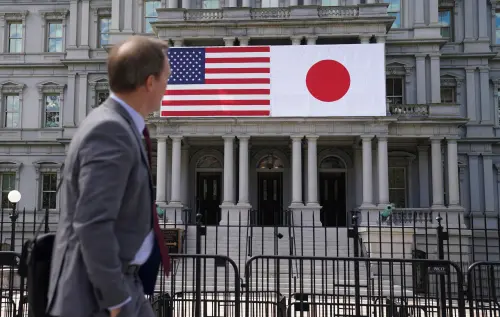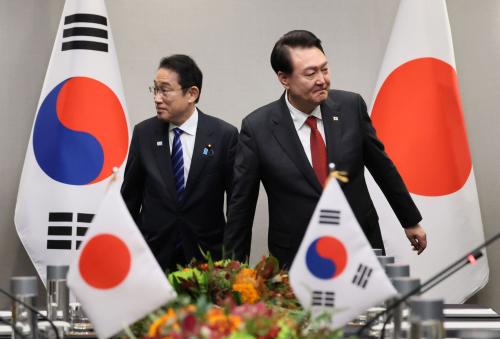Since Japan’s December 2022 release of three major national security documents calling for a “fundament reinforcement” of its defense capabilities, a historic pledge by Japanese Prime Minister Fumio Kishida’s Cabinet to surge Japan’s long-stagnant defense budget — for decades unofficially pegged to 1% of GDP — has rightly attracted global attention. Indeed, it is likely to be the single most important enabler of Japan’s ambitious new national security and defense strategies.
Over the past six months, manifold media reports and expert commentaries have cited these December 2022 documents to claim that the Kishida government has committed Japan to “doubling” its defense budget by 2027. Assertions along these lines have been strikingly widespread, especially in non-Japanese-language reporting and analysis.
Alas, this (now) supposed conventional wisdom remains incorrect, as it was when it first started appearing back in December. The Kishida government has never announced a plan to “double” Japan’s defense budget.
Whether due to misinterpretation of an announced 2% GDP target for all “national security-related spending” or the too-often uncritical echo chamber that permeates much foreign language commentary on Japan’s national security affairs, claims that Japan plans to double its defense spending exaggerate the Kishida government’s actual planned defense budget increases by as much as 35 percentage points.
To avoid misunderstandings and to ensure a healthy public and policy debate in Washington and beyond on a critically important issue with major implications for Japanese and U.S. foreign policy, media and commentators should cease misleading or shorthand references to a (non-existent) Japanese government “plan” to “double” its defense budget.
Signal vs. Noise: What the Kishida government announced last December (and what it did not)
Japan’s new Defense Buildup Program for FY2023-2027 (link to provisional English translation) calls for a combined 43 trillion yen (about $321 billion) in defense spending, which is set to culminate in an FY2027 defense budget target of 8.9 trillion yen (about $66 billion). Put another way, if things go according to plan, Japan’s defense budget in FY2027 will be 65% higher than that of FY2022’s 5.4 trillion yen (about $40 billion).[i] As an alternative comparison, aggregate spending over the new five-year buildup plan (FY2023-2027) is set to exceed that of the previous (FY2019-2023) plan by a combined 56%.[ii]
Clearly, neither a 65% nor 56% planned increase by 2027 is a “doubling” (i.e., a 100% increase) of Japan’s defense budget.
Claims to the contrary are not only inaccurate. My dozens of engagements since last December in Washington and seven other foreign capitals with policymakers, scholars, analysts, and public audiences make clear that such assertions have led to widespread misunderstandings of Japan’s actual intent.
Accurately assessing the numbers matters for sound qualitative analyses about the real-world significance of Japan’s plans. Unsubstantiated assertions of Japan’s (non-existent) plan to double its FY2022 defense budget of 5.4 trillion yen by FY2027 imply a defense budget target of 10.8 trillion yen (about $81 billion). Because the Japanese government’s actual target is 8.9 trillion yen, the claim of “doubling” effectively invents an additional 1.9 trillion yen (about $14 billion) of spending — in a single budget year.
And that’s just the gap between assertion and reality for the final year of Japan’s new FY2023-2027 spending plan. Assuming steady budget increases across the five years, the implied gap between the “doubling” claim and Japan’s stated intent is even greater: as much as $30 billion in cumulative defense investments that Japan has no announced plans to make. This is a significant estimation error — a gap between assertion and reality roughly equivalent to Australia’s entire 2021 defense budget.
But what about Japan’s pledge to reach “2% of GDP?”
Clearly, 8.9 trillion (the planned FY2027 defense budget) divided by 5.4 trillion (FY2022) is not 2.0. And nowhere in the three documents does the Kishida government claim it will double Japan’s defense budget.
So why have so many asserted that the defense budget is set to “double” by 2027?
Two explanations, which are not mutually exclusive, seem most plausible:
- Misunderstanding and/or imprecision with language: Many media/commentators may be misinterpreting the government’s announced plan for Japan’s “national security-related spending” (安保関連費) to reach 2% of (FY2022) GDP by 2027 as a pledge to increase Japan’s official defense budget (防衛費) from 1% to 2% of GDP. No pledge to double Japan’s defense budget appears anywhere in the three documents. In the 2022 National Security Strategy, the 2% of GDP target is explained as encapsulating “fundamental reinforcement of defense capabilities and other complementary initiatives” (emphasis added; “防衛力の抜本的強化とそれを補完する取組をあわせ”). Because this 2% of GDP target includes the defense budget plus several additional spending categories (e.g., Coast Guard budget; certain public infrastructure spending and investments in private-sector science and technology), many analysts are comparing apples to oranges. Accordingly, even more general claims that “national security-spending will double” are also misleading, since this inappropriately baselines the more inclusive 2% of GDP figure against a 1% of GDP figure that refers exclusively to the official defense budget.
- An “echo chamber” effect, especially in non-Japanese reporting and analysis, which frequently appears more driven by sometimes misleading English-language media headlines than independent analysis using official sources (often most authoritative in Japanese).
Regardless, the bottom line is that nowhere in Japan’s December 2022 three documents did the government announce plans to raise the “defense budget” from 1% to 2% of GDP. Rather, the defense budget is to be the largest of several budgets that in aggregate are supposed to add up to approximately 2% of current GDP by 2027.
A planned two-thirds increase is (still) a very, very big deal
As I argue in a new article in The Washington Quarterly, Japan’s pledge to surge its defense budget by 65% over the next five years is the single most significant outcome from last December. It is, simply put, sine qua non for Japan achieving many of its ambitions in the national security space. It is both symbolically historic and practically significant, especially after several decades — including the 2012-2020 “Abe era” — during which an important, if under-reported, storyline was that Japan’s defense budget grew only moderately, remaining around 1% of GDP throughout former Prime Minister Shinzo Abe’s tenure.
Indeed, one major consequence of Japan’s relatively stagnant defense spending in recent years, inclusive of “the Abe years,” was the emergence of a widely-overlooked but yawning gap between successive governments’ stated national security ambitions and tight resourcing constraints. No wonder, therefore, that much of Japan’s just-announced FY2023 defense budget is allocated to addressing long-neglected, chronic issues: such as improving munitions and parts stockpiles, equipment, facilities, and conditions for Japan Self-Defense Forces personnel.
The FY2023 defense budget, which cleared the Diet several weeks ago, makes abundantly clear that the Kishida government is both serious about rapidly increasing Japan’s defense capabilities and not wasting any time. At approximately 6.8 trillion yen (about $51 billion), this year’s official budget reflects a historic 26% year-on-year increase that in absolute yen terms is larger than Tokyo’s combined defense budget increases of the past 30 years.
Needless to say, after years of relative defense budget stagnation this is all a very (very) big deal. Though there are legitimate questions about how much of the five-year plan Japan will be able to fully implement given competing priorities for limited resources and political, fiscal, and other headwinds, there is no question that a significant new chapter in Japan’s national security evolution has already begun.
A final word
The commitment by the world’s third-largest economy and a major U.S. treaty ally to increase defense spending by two-thirds in just a half-decade is a historic and profoundly significant development. Against the backdrop of a rapidly worsening regional and global security environment and balance of power in Northeast Asia, Japan’s planned spending surge is a potential game-changer for both Japan and the U.S.-Japan alliance, as well as their shared efforts to “strongly oppose any unilateral attempts to change the status quo by force or coercion,” in Northeast Asia and beyond.
But facts (and math) matter for assessing the real-world significance of Japan’s new national security and defense strategies.
Widespread claims that Japan plans to “double” its defense budget continue to confuse far more than they enlighten. They muddle public understanding of an extremely important issue with significant real-world implications for Japan, the U.S.-Japan alliance, East Asia, and the world. After all, Japan’s defense spending is likely to be a fundamental variable determining whether Japan’s leaders succeed in fully implementing the ambitions contained within Japan’s new national security and defense strategies. Related assessments and debates would be well-served by starting from a common understanding of the defense budget targets to which Tokyo has actually committed over the next five years.
Note on figures:
[i] The 65% calculation comes from dividing the December 2022 FY2027 defense budget target of 8.9 trillion yen by the FY2022 budget of 5.4 trillion yen.
[ii] The 56% calculation results from dividing the planned FY2023-2027 aggregate spending figure of 43 trillion yen by the 27.5-trillion-yen figure from the previous five-year plan [FY2019-2023], which appeared in the (now obsolete) 2018 National Defense Program Guidelines
Editor’s note: A prior version of this article stated that “claims that Japan plans to double its defense spending exaggerate the Kishida government’s actual planned defense budget increases by as much as 35%.” The correct number is 35 percentage points or 54%.









Commentary
No, Japan is not planning to “double its defense budget”
May 22, 2023